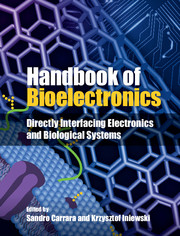Book contents
- Frontmatter
- Contents
- List of Contributors
- 1 What is bioelectronics?
- Part I Electronic components
- Part II Biosensors
- Part III Fuel cells
- Part IV Biomimetic systems
- Part V Bionics
- Part VI Brain interfaces
- 27 Introduction to brain–machine interfaces
- 28 ECG technology for the brain–machine interface
- 29 Reducing the implant footprint: low-area neural recording
- 30 Electrical stimulation
- 31 Biological channel modeling and implantable UWB antenna design for neural recording systems
- 32 Intracranial epilepsy monitoring using wireless neural recording systems
- 33 Low-power building blocks for neural recording systems
- 34 CMOS circuits for intracellular brain–machine interfaces
- Part VII Lab-on-a-chip
- Part VIII Future perspectives
- Index
- References
28 - ECG technology for the brain–machine interface
from Part VI - Brain interfaces
Published online by Cambridge University Press: 05 September 2015
- Frontmatter
- Contents
- List of Contributors
- 1 What is bioelectronics?
- Part I Electronic components
- Part II Biosensors
- Part III Fuel cells
- Part IV Biomimetic systems
- Part V Bionics
- Part VI Brain interfaces
- 27 Introduction to brain–machine interfaces
- 28 ECG technology for the brain–machine interface
- 29 Reducing the implant footprint: low-area neural recording
- 30 Electrical stimulation
- 31 Biological channel modeling and implantable UWB antenna design for neural recording systems
- 32 Intracranial epilepsy monitoring using wireless neural recording systems
- 33 Low-power building blocks for neural recording systems
- 34 CMOS circuits for intracellular brain–machine interfaces
- Part VII Lab-on-a-chip
- Part VIII Future perspectives
- Index
- References
Summary
Electrocardiography (ECG) is the acquisition of electrical activity of the heart captured over time by an external electrode attached to the skin. Each of the cell membranes that form the outer covering of the heart cell has an associated charge which is depolarized during every heartbeat. These appear as tiny electrical signals on the skin which can be detected and amplified by an electrical circuit.
History of ECG
Alexander Muirhead is reported to have recorded a patient’s heartbeat initially in 1872. In the early twentieth century, Willem Einthoven used a string galvanometer to measure the electrical activity of the heart. In those days, patients had to immerse their limbs into salt solutions from which the ECG was recorded. Nowadays, the ECG machine can be carried around in a patient’s pocket and has become truly mobile. Einthoven assigned the letters P, Q, R, S, T to various deflections in the wave and identified features of a number of disorders based on the deflections. He was awarded the Nobel Prize in medicine for his discovery. Even though many advances have been made in the field of ECG, the basic principles are still valid even today.
Sample waveforms of ECG
The ECG signal is characterized by peaks and troughs as shown in Figure 28.1. For each beat of the heart, a similar sequence is generated owing to contraction and relaxation of various muscles of the heart. The ECG signal is plotted on graph paper as shown in Figure 28.2.
- Type
- Chapter
- Information
- Handbook of BioelectronicsDirectly Interfacing Electronics and Biological Systems, pp. 344 - 351Publisher: Cambridge University PressPrint publication year: 2015



